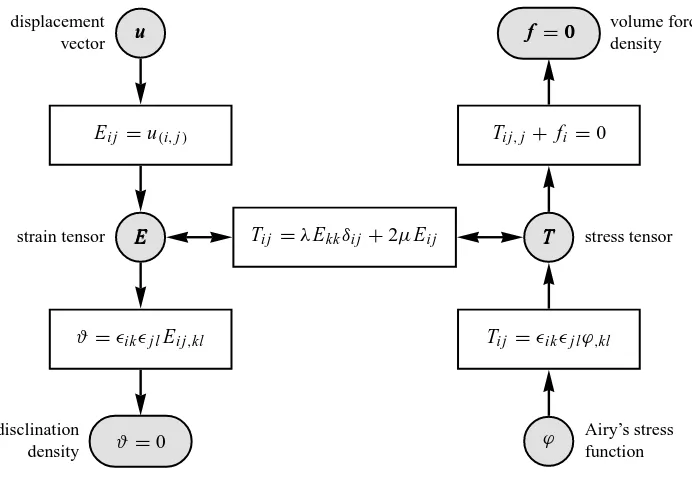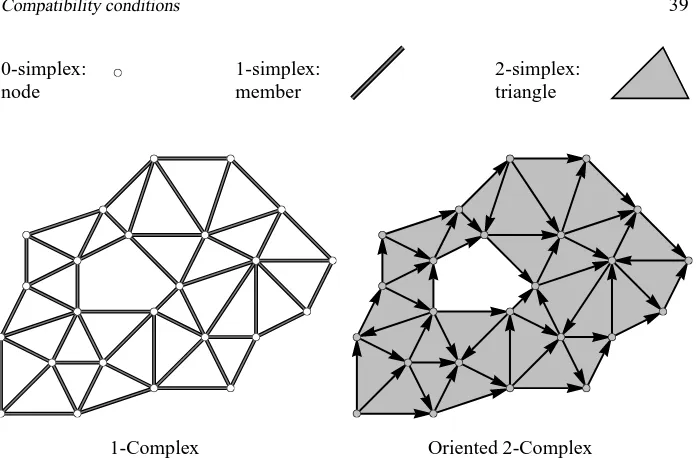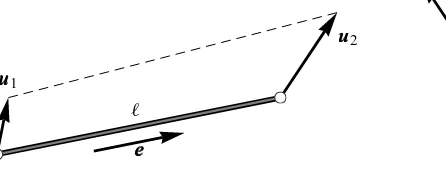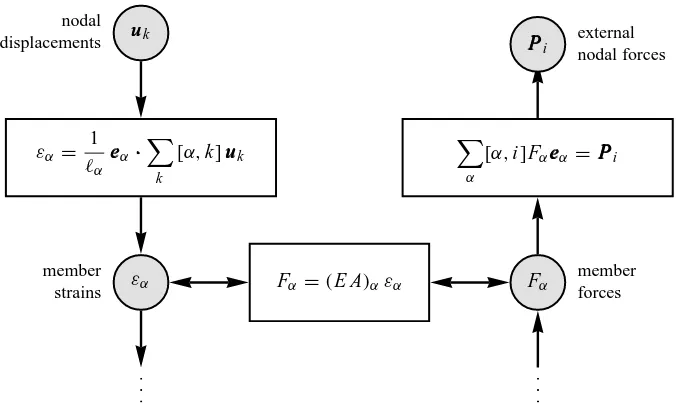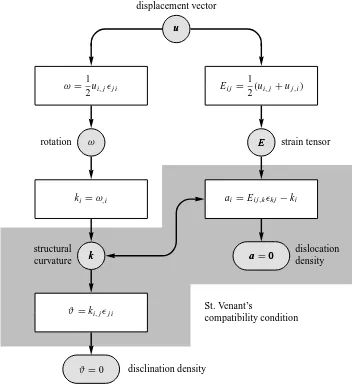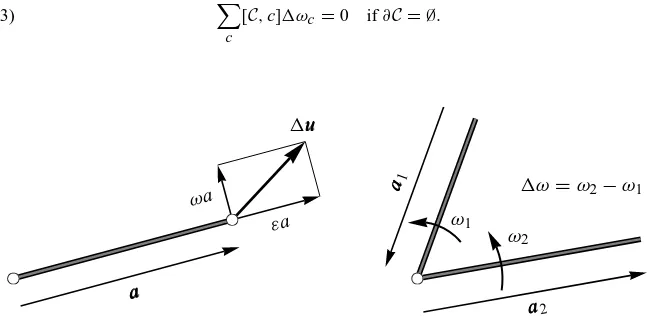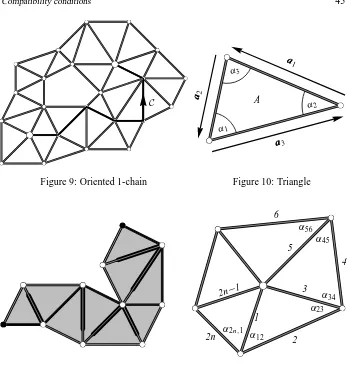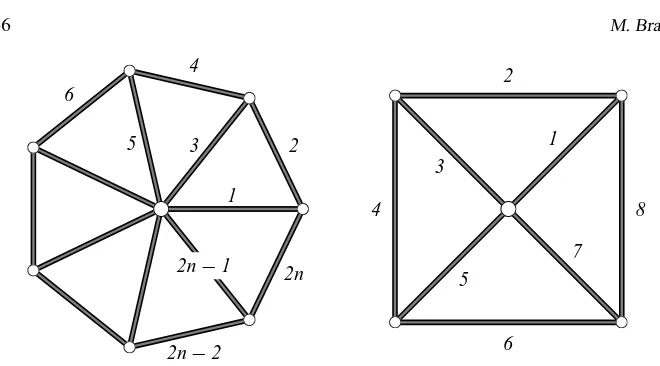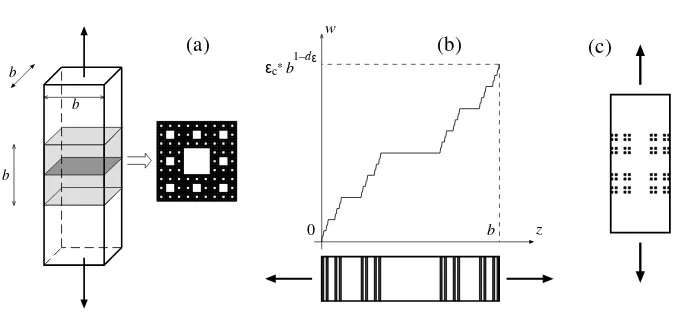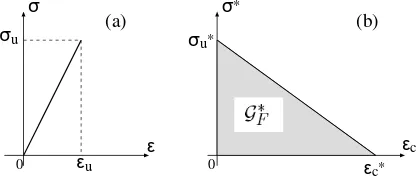DEL
S
EMINARIO
M
ATEMATICO
Universit`a e Politecnico di Torino
Geometry, Continua and Microstuctures, I
CONTENTS
E. Binz - S. Pods - W. Schempp, Natural microstructures associated with singularity free
gradient fields in three-space and quantization . . . . 1 E. Binz - D. Socolescu, Media with microstructures and thermodynamics from a
mathe-matical point of view . . . 17
L. Bortoloni - P. Cermelli, Statistically stored dislocations in rate-independent plasticity . 25 M. Braun, Compatibility conditions for discrete elastic structures . . . 37 M. Brocato - G. Capriz, Polycrystalline microstructure . . . 49 A. Carpinteri - B. Chiaia - P. Cornetti, A fractional calculus approach to the mechanics of
fractal media . . . 57
S. Cleja-T¸ igoiu, Anisotropic and dissipative finite elasto-plastic composite . . . 69 J. Engelbrecht - M. Vendelin, Microstructure described by hierarchical internal variables . 83 M. Epstein, Are continuous distributions of inhomogeneities in liquid crystals possible? . . 93 S. Forest - R. Parisot, Material crystal plasticity and deformation twinning . . . 99 J. F. Ganghoffer, New concepts in nonlocal continuum mechanics . . . 113 S. G¨umbel - W. Muschik, GENERIC, an alternative formulation of nonequilibrium
con-tinuum mechanics? . . . 125
In 1997 Gerard Maugin organized the first International Seminar on “Geometry, Continua and Microstructures” at the P. and M. Curie University in Paris. The success of the Seminar induced the organizers to repeat it in Madrid (1998) and in Bad Herrenalb (1999). Hence, when Gerard Maugin asked me to organize the fourth edition of the Seminar in Turin, I accepted with pleasure and I am now honoured to present the proceedings of the 4thInternational Seminar , which was held at the Department of Mathematics of the University of Turin from October 26th -28th, 2000.
The proceedings of the meeting appear as a special issue of the Rendiconti del Seminario Matem-atico (Universit`a e Politecnico di Torino) and I am indebted to the Editor, Andrea Bacciotti, who gave me the opportunity to publish the papers in this journal.
The meeting, as the previous ones, was successful and dense with scientific results, as demon-strated by the contents, the number of lectures, the 23 papers which fill two volumes of the proceedings as well as the high scientific level of participants (about 50 scientists and young researchers from many different countries of Europe, Israel, Canada, U.S.A, and Russia). The focus of the Seminar was the modelling of new phenomena in continuum mechanics which require the introduction of non-standard descriptors. The framework is Rational Continuum Me-chanics which encompasses all descriptions of new phenomena from the macroscopic point of view. Processes occurring at microscopic scales are then taken into account by suitable general-ized parameters. The introduction of these new descriptors has enriched the classical framework, since they often take values in manifolds with non trivial topological and differential structure (i.e. liquid crystals) and the purpose of the Seminar was just to discuss and point out the various problems related to these topics.
The lectures appearing in this volume provide an up-to-date insight of the state of the art and of the more recent evolution of research, with many new relevant results. Such evolution emerged clearly from the proceedings of the previous meetings and this volume represents a step along the way. In fact, a 5thInternational Seminar bearing the same title and focusing on the same topics has been organized by Sanda ClejaTigoiu in Sinaia (Rumania) from Seprember 25th -28th, 2001 and will surely constitute a new milestone for future developments in this field of research.
Acknowledgements.
I am grateful to the members of the organizing committee (Manuelita Bonadies, Luca Bortoloni, Paolo Cermelli, Gianluca Gemelli, Maria Luisa Tonon) who made this meeting possible and suc-cessful and allowed this volume to be finished, notwithstanding some hindrances and difficulties. I would also like to thank:
the Department of Mathematics of the University of Turin for providing the meeting room, the facilities and the necessary assistance;
the University of Turin for the financial support;
the M.U.R.S.T. for the funding provided through the research project COFIN 2000 “Modelli Matematici in Scienza dei Materiali”;
the co-ordinator of this research project, Paolo Podio Guidugli, for his generosity.
Torino, 26-28 October 2000
List of partecipants
Gianluca Allemandi
Dipartimento di Matematica, Universit`a di Torino Via Carlo Alberto 10
10123, Torino, Italy Phone: +39 0349 2694243 e-mail:[email protected] Albrecht Bertram
Institut f¨ur Mechanik Otto-von-Guericke, Universit¨at Magdeburg Universit¨atsplatz 2
D-39106 Magdeburg, Germany Phone: +391 67 18062 Fax: +391 67 12863
e-mail:[email protected] Ernst Binz
Fakult¨at f¨ur Mathematik und Informatik, Universit¨at Mannheim Lehrstuhl f¨ur Mathematik 1, D7, 27, Raum 404
D-68131 Mannheim, Germany Phone: +391 621 2925389 Fax: +391 621 2925335
e-mail:[email protected] Luca Bortoloni
Dipartimento di Matematica, Universit`a di Bologna Piazza di Porta San Donato 5
40127 Bologna, Italy
e-mail:[email protected] Manfred Braun
Department of Mechanics, University of Duisburg 47048 Duisburg, Germany
Phone: +49 203 3793342 Fax: +49 203 3792494
e-mail:[email protected] Gianfranco Capriz
56126 Pisa, Italy
e-mail:[email protected] Alberto Carpinteri
Dipartimento Ingegneria Strutturale e Geotecnica, Politecnico di Torino Corso Duca degli Abruzzi 24
10129 Torino, Italy Phone: +39 011 5644850 e-mail:[email protected] Paolo Cermelli
Dipartimento di Matematica, Universit`a di Torino Via Carlo Alberto 10
10123 Torino, Italy
e-mail:[email protected] Bernardino Chiaia
Dipartimento Ingegneria Strutturale e Geotecnica, Politecnico di Torino Corso Duca degli Abruzzi 24
10129 Torino, Italy Phone: +39 011 5644866 Fax: +39 011 5644899 e-mail:[email protected] Vincenzo Ciancio
Dipartimento di Matematica, Universit`a di Messina Contrada Papardo, Salita Sperone 31
98166 Messina, Italy Phone: +39 090 6765061 Fax: +39 090 393502
e-mail:[email protected] Sanda Cleja-Tigoiu
Department of Mechanics, Faculty of Mathematics, University of Bucharest Str. Accademiei, 14
70109 Bucharest, Romania Phone: 6755118
e-mail:[email protected] Fiammetta Conforto
Dipartimento di Matematica, Universit`a di Messina Contrada Papardo, Salita Sperone 31
98166 Messina, Italy Phone: +39 090 6765063 Fax: +39 090 393502
Piero Cornetti
Dipartimento Ingegneria Strutturale e Geotecnica, Politecnico di Torino Corso Duca degli Abruzzi 24
10129 Torino, Italy Phone: +39 011 5644901 e-mail:[email protected] Antonio Di Carlo
Dipartimento di Scienze dell’Ingegneria Civile, Facolt`a di Ingegneria, Universit`a di Roma 3 Via Corrado Segre 60
00146 Roma, Italy
Phone: +39 06 55175002/3/4/5 e-mail: [email protected] Juri Engelbrecht
Department of Mechanics and Applied Mathematics, Tallinn Technical University Akadeemia tee, 21
12618 Tallinn, Estonia Phone: +37 26 442129 Fax: +37 26 451805 e-mail:[email protected] Marcelo Epstein
Department of Mechanical and Manufacturing Engineering, University of Calgary Calgary, Alberta T2N1 N4, Canada
Phone: 1-403-220-5791, Fax: 1-403-282-8406
e-mail:[email protected]@agt.net Samuel Forest
Ecole Nationale Superieure des Mines de Paris Centre des Materiaux / UMR 7633, B.P. 8791003 91003 Evry, France
Phone: +33 1 60763051 Fax: +33 1 60763150
e-mail:[email protected] Jean-Francois Ganghoffer
Lemta- Ensem
2, Avenue de la Foret de Haye, B.P. 160- 54504 Vandoeuvre Cedex, France
Phone : +33 0383595530 Fax : +33 0383595551
e-mail:[email protected] Sebastian G¨umbel
D-10623 Berlin, Germany Phone: +49 030 31423000 Fax: +49 030 31421130
e-mail:[email protected] Klaus Hackl
Lehrstuhl f¨ur Allgemeine Mechanik Ruhr-Universit¨at Bochum
D-44780 Bochum, Germany Phone: +49 234 3226025 Fax: +49 234 3214154
e-mail:[email protected] Heiko Herrmann
Institut f¨ur Theoretische Physik, Technische Universit¨at Berlin Sekretariat PN7-1, Hardenbergstrasse 36
D-10623 Berlin, Germany Phone: +49 030 31424443 Fax: +49 030 31421130
e-mail:[email protected] Yordanka Ivanova
Institute of Mechanics and Biomechanics, B.A.S. Sofia, Bulgaria
Phone: +359 27131769 e-mail:[email protected] Akiko Kato
Institut f¨ur theoretische Physik, Technische Universitaet Berlin Sekretariat PN7-1, Hardenbergstrasse 36
D-10623 Berlin, Germany, Phone: +49 030 31424443 Fax: +49 030 31421130
e-mail:[email protected] Massimo Magno
Groupe Securite et Ecologie Chimiques, Ecole Nationale Superieure de Chimie de Mulhouse 3, Rue Alfred Werner
F-68093 Mulhouse Cedex, France e-mail:[email protected] Chi-Sing Man
Department of Mathematics, University of Kentucky 715 Patterson Office Tower
Gerard A. Maugin
Laboratoire de Modalisation en Mecanique, Universite Pierre et Marie Curie Case 162, 8 rue du Capitaine Scott
75015 Paris, France
Phone: +33 144 275312, Fax: +33 144 275259 e-mail:[email protected]
Marco Mosconi
Istituto di Scienza e Tecnica delle Costruzioni, Universit`a di Ancona Via Brecce Bianche, Monte d’Ago
60131 Ancona, Italy Phone: +39 0171 2204553 Fax: +39 0171 2204576
e-mail:[email protected] Wolfgang Muschik
Institut f¨ur Theoretyche Physik, Technische Universit¨at Berlin Sekretariat PN7-1 , Hardenbergstrasse 36
D-10623 Berlin, Germany
Phone: +49 030 31423765, Fax: +49 030 31421130 e-mail:[email protected] Rodolphe Parisot
Ecole Nationale Superieure des Mines de Paris Centre des Materiaux / UMR 7633, B.P. 8791003 91003 Evry, France
Phone: +33 01 60763061 Fax: +33 01 60763150
e-mail:[email protected] Alexey V. Porubov
loffe Physico-Technical Institute of the Russian Academy of Sciences Polytechnicheskaya st., 26
194021 Saint Petersburg, Russia Phone: +7 812 2479352 Fax: +7 812 2471017
e-mail:[email protected] Guy Rodnay
Department of Mechanical Engineering, Ben-Gurion University 84105 Beer-Sheva, Israel
Phone: +972 54 665330 Fax: +972 151 54 665330
e-mail:[email protected] Patrizia Rogolino
98166 Messina, Italy
e-mail:[email protected] Gunnar Rueckner
Institut f¨ur Theoretische Physik, Technische Universit¨at Berlin Sekretariat PN7-1, Hardenbergstrasse 36
D-10623 Berlin, Germany Phone: +49 030 31424443 Fax: +49 030 31421130
e-mail:[email protected] Giuseppe Saccomandi
Dipartimento di Ingegneria dell’Innovazione, Universit`a di Lecce Via Arnesano
73100 Lecce, Italy
e-mail:[email protected] Reuven Segev
Department of Mechanical Engineering, Ben-Gurion University P.O. Box 653,
84105 Beer-Sheva, Israel Phone: +972 7 6477108 Fax: +972 7 6472813
e-mail:[email protected] Dan Socolescu
Fachbereich Mathematik, Universit¨at Kaiserslautern 67663 Kaiserslautern, Germany
Phone: +49 631 2054032 Fax: +49 631 2053052
e-mail:[email protected] Bob Svendsen
Department of Mechanical Engineering, University of Dormtund D-44221 Dormtund, Germany,
Phone: +49 231 7552686 Fax: +49 231 7552688
e-mail:[email protected] Carmine Trimarco
Dipartimento Matematica Applicata “U. Dini”, Universit`a di Pisa Via Bonanno 25/B
I-56126 Pisa, Italy Tel. +39 050 500065/56 Fax: +39 050 49344
Robin Tucker
Department of Physics, Lancaster University Lancaster LA1 4Y, UK
Phone: +44 0152 4593610 Fax: +44 0152 4844037
e-mail:[email protected] Varbinca Valeva
Institute of Mechanics and Biomechanics, B.A.S. ul Ac. Bonchev bl 4
Geom., Cont. and Micros., I
E. Binz - S. Pods - W. Schempp
NATURAL MICROSTRUCTURES ASSOCIATED WITH
SINGULARITY FREE GRADIENT FIELDS IN THREE-SPACE
AND QUANTIZATION
Abstract.
Any singularity free vector field X defined on an open set in a three-dimen-sional Euclidean space with curl X =0 admits a complex line bundle Fawith a fibre-wise defined symplectic structure, a principal bundlePa and a Heisenberg group bundle Ga. For the non-vanishing constant vector field X the geometry of Pa defines for each frequency a Schr¨odinger representation of any fibre of the Heisenberg group bundle and in turn a quantization procedure for homogeneous quadratic polynomials on the real line.
1. Introduction
In [2] we described microstructures on a deformable medium by a principal bundle on the body manifold. The microstructure at a point of the body manifold is encoded by the fibre over it, i.e. the collection of all internal variables at the point. The structure group expresses the internal symmetries.
In these notes we will show that each singularity free gradient field defined on an open set of the Euclidean space hides a natural microstructure. The structure group is U(1).
If the vector field X is a gradient field with a nowhere vanishing principal part a, say, then there are natural bundles over O such as a complex line bundle Fawith a fibre-wise defined symplectic formωa, a Heisenberg group bundle Gaand a four-dimensional principal bundlePa
with structure group U(1). (Fibres over O are indicated by a lower index x.) For any x∈O the
fibre Fxais the orthogonal complement of a(x)formed in E and encodes internal variables at x. It is, moreover, identified as a coadjoint orbit of Gax. The principal bundlePa, a subbundle of
the fibre bundle Fa, is equipped with a natural connection formαa, encoding the vector field in terms of the geometry of the local level surfaces: The field X can be reconstructed fromαa. The collection of all internal variables provides all tangent vectors to all locally given level surfaces. The curvatureaofαadescribes the geometry of the level surfaces of the gradient field in terms ofωaand the Gaussian curvature.
There is a natural link between this sort of microstructure and quantum mechanics. To demonstrate the mechanism we have in mind, the principal part a of the vector field X is assumed to be constant (for simplicity only). Thus the integral curves, i.e. the field lines, are straight lines. Fixing some x∈O and a solution curveβpassing through x∈ O, we consider the collection of
all geodesics on the restriction of the principal bundlePatoβ. Each of these geodesics with the same speed is called a periodic lift ofβand passes through a common initial pointvx ∈Pxa, say.
If the periodic lifts rotate in time, circular polarized waves are established. Hence the integral
curveβis accompanied by circular polarized waves onPaof arbitrarily given frequencies. This
collection of periodic lifts ofβdefines unitary representationsρν of the Heisenberg group Gax,
the Schr¨odinger representations (cf. [11] and [13]). The frequencies of the polarized waves correspond to the equivalence classes ofρνdue to the theorem of Stone-von Neumann.
The automorphism group of Gaxis the symplectic group Sp(Fxa)of the symplectic complex line Fxa. Therefore, the representationρ1of Gax yields a projective representation of Sp(Fxa),
due to the theorem of Stone-von Neumann again. This projective representation is resolved to a unitary representation W of the metaplectic group M p(Fxa)in the usual way. Its infinitesimal representation d W of the Lie algebra mp(Fxa)of M p(Fxa)yields the quantization procedure for all homogeneous quadratic polynomials defined on the real line. Of course, this is in analogy to the quantization procedure emanating from the quadratic approximation in optics.
2. The complex line bundle associated with a singularity free gradient field in Euclidean space
Let O be an open subset not containing the zero vector 0 in a three-dimensional orientedR -vector space E with scalar product< , >. The orientation on the Euclidean space E shall be represented by the Euclidean volume formµE.
Our setting relies on a smooth, singularity free vector field X : O−→O×E with principal
part a : O−→E , say. We shall frequently identify X with its principal part.
Moreover, letH:=R·e⊕E be the skew field of quaternions where e is the multiplicative
unit element. The scalar product< , > and the orientation on E extend to all ofH such that e ∈ His a unit vector and the above splitting of His orthogonal. The unit sphere S3, i.e. Spi n(E), is naturally isomorphic to SU(2)and covers S O(E)twice (cf. [8] and [9]).
Given any x ∈O, the orthogonal complement Fxaof a(x)∈E is a complex line as can be
seen from the following: LetCa
x ⊂Hbe the orthogonal complement of Fxa. Hence the field of
quaternionsHsplits orthogonally into
(1) H=Ca
x⊕Fxa.
As it is easily observed,
Cax =R·e⊕R· a(x) |a(x)|
is a commutative subfield ofHnaturally isomorphic toCdue to
a(x)
|a(x)| 2
= −e ∀x∈O,
where| · |denotes the norm defined by< , >. This isomorphism shall be called
jxa:C−→Cax; it maps 1 to e and i to a(x)
|a(x)|. The multiplicative group on the unit circle ofCax is denoted by Uxa(1). It is a subgroup of SU(2)⊂ Hand hence a group of spins. Obviously a(x)generates the Lie algebra of Uxa(1).
Fxais aCax-linear space under the (right) multiplication ofHand hence aC-linear space, a complex line. Moreover,His the Clifford algebra of Fxaequipped with−< , >(cf. [9]).
The topological subspace Fa := Sx∈O{x} ×Fxaof O ×E is aC-vector subbundle of
the complex line bundle associated with X . Let pra: Fa−→O be its projection. Accordingly
there is a bundle of fieldsCa−→O with fibreCaxat each x∈ O. Clearly, O×H=Ca×Fa
as vector bundles over O. Of course, the bundle Fa−→O can be regarded as the pull-back of T S2via the Gauss map assigning |aa((xx))|to any x∈O.
We, therefore, assume that curl X = 0 from now on. Due to this assumption there is a locally given real-valued function V , a potential of a, such that a = grad V . Each (locally given) level surface S of V obviously satisfies T S=Fa|S. Here Fa|S=Sx∈S{x} ×Fxa. Each
fibre Fxaof Fais oriented by its Euclidean volume form ia(x) |a(x)|
µE :=µE
a(x)
|a(x)|, . . . , . . .
. For any level surface the scalar product yields a Riemannian metric gSon S given by
gS(x;vx, wx):=< vx, wx > ∀x∈O and ∀vx, wx ∈TxS.
For any vector field Y on S, any x ∈ O and anyvx ∈ TxS, the covariant derivative∇S of
Levi-Civit`a determined by gSsatisfies
∇vSxY(x) = dY(x;vx)+<Y(x),W
a x(vx) > .
Here Wxa : TxS −→ TxS is the Weingarten map of S assigning to eachwx ∈ TxS the vector d a
|a|(x;wx), the differential of a
|a|at x evaluated atwx. The Riemannian curvature R of∇Sat
any x is expressed by the well-known equation of Gauss as
R(x;vx, wx.ux,yx) = <Wxa(wx),ux >·<Wxa(vx),yx>
(2)
−<Wxa(vx),ux >·<Wxa(wx),yx>
for any choice of the vectorsvx, wx,ux,yx∈TxS.
A simple but fundamental observation in our setting is that each fibre Fxa ⊂ Facarries a natural symplectic structureωadefined by
ωa(x;h,k):=<h×a(x),k>=<h·a(x),k> ∀h,k∈Fxa,
where×is the cross product, here being identical with the product inH. In the context of Fxaas a complex line we may write
ωa(x;h0,h1)= |a(x)|·<h0·i,h1> .
This is due to the fact that h and a(x)are perpendicular elements in E . The bundle Fais fibre-wise oriented by−ωa. In factωaextends on all of E by setting
ωa(x;y,z):=<y×a(x),z>
for all y,z ∈ E ; it is not a symplectic structure on O, of course. Letκ(x) := det Wxa for all
x∈S, the Gaussian curvature of S. Providedvx, wxis an orthonormal basis of TxS, the relation
between the Riemannian curvature R andωis given by
R(x;vx, wx.ux,yx)= κ(x) |a(x)|·ω
a(x;ux,yx)
3. The natural principal bundlePaassociated with X
We recall that the singularity free vector field X on O has the form X =(id,a). LetPa x ⊂ Fxa
be the circle centred at zero with radius|a(x)|−12 for any x∈ O. Then Pa:= [
x∈O
{x} ×Pxa
equipped with the topology induced by Fais a four-dimensional fibre-wise oriented submanifold of Fa. It inherits its smooth fibre-wise orientation from Fa. Moreover,Pais a U(1)-principal bundle. U(1)acts from the right on the fibrePa
x ofPavia jxa|U(1) : U(1)−→Uxa(1)for any x ∈ O. This operation is fibre-wise orientation preserving. The reason for choosing the radius
ofPa
x to be|a(x)|− 1
2 will be made apparent below.
Both FaandPaencode collections of internal variables over O and both are constructed out of X , of course. Clearly, the vector bundle Fais associated withPa.
The vector field X can be reconstructed out of the smooth, fibre-wise oriented principal bundlePa as follows: For each x ∈ O the fibrePa
x is a circle in Fxa centred at zero. The
orientation of this circle yields an orientation of the orthogonal complement of Fxaformed in
E , the direction of the field at x. Hence|a(x)|is determined by the radius of the circlePa x.
Therefore, the vector field X admits a characteristic geometric object, namely the smooth, fibre-wise oriented principal bundlePaon which all properties of X can be reformulated in geometric terms. Vice versa, all geometric properties ofPa reflect characteristics of a. The fibre-wise
orientation can be implemented in a more elegant way by introducing a connection form,αa, say, which is in fact much more powerful. This will be our next task. SincePa⊂ O×E , any
tangent vectorξ∈TvxPacan be represented as a quadruple
ξ=(x, vx,h, ζvx)∈O×E×E×E
for x∈O,vx ∈Pxaand h, ζvx ∈E ⊂Hwith the following restrictions, expressing the fact that
ξis tangent toPa:
Given a curveσ=(σ1, σ2)onPawithσ1(s)∈O andσ2(s)∈Pσa
1(s)for all s, then
< σ2(s),a(σ1(s)) >= 0 and |σ2(s)|2= 1
|a(σ1(s))| ∀ s.
Eachζ∈TvxPagiven byζ =
·
σ2(0)is expressed as
ζ=r1· a(x)
|a(x)|+r2·
vx |vx|+r·
vx×a(x) |vx| · |a(x)|
with
r1= −<Wxa(vx),h> , r2= −|
vx|
2 ·d ln|a|(x;h) and a free parameter r∈R. The Weingarten map Wxais of the form
da(x;k)= |a(x)| ·Wxa(k)+a(x)·d ln|a|(x;k) ∀x∈O, ∀k∈E,
where we set Wxa(a(x))=0 for all x ∈O. With these preparations we define the one-form
for eachξ∈TPawithξ=(x, v
x,h, ζ )to be
αa(vx, ξ ):=< vx×a(x), ζ > .
(3)
One easily shows thatαais a connection form (cf. [10] and for the field theoretic aspect [1]). To match the requirement of a connection form in this metric setting, the size of the radius ofPa x
is crucial for any x∈ O. The negative of the connection form onPais in accordance with the smooth fibre-wise orientation, of course.
Thus the principal bundlePatogether with the connection formαacharacterizes the vector field X , and vice versa. To determine the curvaturea which is defined to be the exterior covariant derivative ofαa, the horizontal bundles in TPawill be characterized. Givenv
x∈Pa,
the horizontal subspace H orvx ⊂TPais defined by
H orvx :=kerα
a(vx;. . .).
A vectorξvx ∈H orvx, being orthogonal tovx×a(x), has the form(x, vx,h, ζhor)∈O×E×
E×E where h varies in O andζhorsatisfies
ζhor = − <Wxa(vx),h>· a(x)
|a(x)|− |vx|
2 ·d ln|a|(x;h)·
vx |vx|.
Since T pra : H orvx −→ TxO is an isomorphism for anyvx ∈ Pa, dim H orvx = 3 for all
vx ∈ Paand for all x ∈ O. The collection H or ⊂ TPa of all horizontal subspaces in the
tangent bundle TPainherits a vector bundle structure TPa.
The exterior covariant derivative dhorαais defined by
dhorαa(vx, ξ0, ξ1):=dαa(vx;ξ0hor, ξ1hor)
for everyξ0, ξ1∈TvxPa,vx ∈Pxaand x∈O.
The curvaturea := dhorαaof αa is sensitive in particular to the geometry of the (locally given) level surfaces, as is easily verified by using equation (2):
PROPOSITION1. Let X be a smooth, singularity free vector field on O with principal part
a. The curvatureaof the connection formαais
a= κ |a|·ω
a
whereκ : O −→ Ris the leaf-wise defined Gaussian curvature on the foliation of O given by the collection of all level surfaces of the locally determined potential V . The curvaturea
vanishes along field lines of X .
The fact that the curvatureavanishes along field lines plays a crucial role in our set-up. It will allow us to establish (on a simple model) the relation between the transmission of internal variables along field lines of X and the quantization of homogeneous quadratic polynomials on the real line.
4. Two examples
a principal part having the non-zero value a∈E for all x∈ O. Obviously the principal bundle Pais trivial, i.e.
Pa∼=O×Ua(1).
Since an integral curveβof X is a straight line segment parametrized by
β(t)=t·a+x0 with β(t0)=x0,
the restrictionPa|im
β ofPato the image i mβis a cylinder with radius|a|− 1 2.
As the second type of example of a principal bundlePaassociated with a singularity free
vector field let us consider a central symmetric field X = grad Vsol on E\{0}with the only
singularity at the origin. The potential Vsolis given by Vsol(x):= − ¯
m
|x| ∀x∈O
wherem is a positive real. This potential governs planetary motions and hence grad V¯ sol is
called the solar field here. The principal part a of the gradient field is grad Vsol(x)= − m¯
|x|2· x
|x| ∀x∈E\{0}.
(4)
For reasons of simplicity we illustrate from a longitudinal point of view the principal bundlePa
associated with the gradient field. An integral curveβpassing through x at the time t0=1 is of
the form
β(t)= − ¯m·(3·t−2)13 ·x for 2
3<t<∞. (5)
Hence the (trivial) principal bundlePa|im
βis a cone. The radius r of a circlePaxwith x∈i mβ
is r= √|x| ¯
m for all x∈O (cf. [12]).
5. Heisenberg group bundles associated with the singularity free vector field and curves and the solar field
Associated with the(2+1)-splitting of the Euclidean space E caused by the vector field X there is a natural Heisenberg group bundle Gawithωaas symplectic form. The bundle Gaallows us to reconstruct X as well. Heisenberg groups play a central role in signal theory (cf. [13], [14]). We essentially restrict us to the two types of examples presented in the previous section.
Given x ∈ O, the vector a(x)6=0 determines Fxawith the symplectic structureωa(x)and Ca
xwhich decomposeHaccording to (1).
The submanifold Gax := |a(x)|−12 ·e·Uxa(1)⊕Fxa ofHcarries the Heisenberg group structure the (non-commutative) multiplication of which is defined by
(z1+h1)·(z2+h2):= |a(x)|−
1
2 ·z1·z2·e 1
2·ωa(x;h1,h2)·|aa|+h1+h2
(6)
for any two z1,z2∈ |a(x)|−
1 2·e·Ua
x(1)and any pair h1,h2∈Fxa(cf. [12]). The (commutative)
multiplication in the centre|a(x)|12 ·e·Uxa(1)of Gax is given by adding angles. The reason the centre has radius|a(x)|−12 is the length scale onPa
∪x∈O{x} × |a(x)|− 1 2·e·Ua
x(1), which is the collection of all centres, is associated withPaand
forms a natural torus bundle together withPa. The collection Ga:= [
x∈O
{x} ×Gax
can be made into a group bundle which is associated with the principal bundlePa, too. Clearly Fa⊂Gaas fibre bundles. In the cases of a constant vector field and the solar field the Heisen-berg group bundle along field lines is trivial.
In particular, a in (6) takes the values|a(x)|−12 = |a|−21 and|a(x)|−12 = |x|
¯
m for all x∈ O
in the cases of the constant vector field respectively the solar field. The Lie algebraGxaof Gaxis
Gxa:=R· a |a|⊕F
a x
together with the operation
ϑ1·
a
|a|+h1, ϑ2· a |a|+h2
:=ωa(x;h1,h2)· a |a|
for anyϑ1, ϑ2 ∈ Rand any h1,h2 ∈ Fxa. The exponential map expGa x : G
a
x −→ Gax is
surjective. Obviously, X can be reconstructed from both Ga andGa. The coadjoint orbit of Ada∗passing through< ϑ·|aa|+h1, .. >∈Gxa∗withϑ6=0 isϑ·|aa|⊕Fxa.
In this context we will study the solar field next (cf. [12]). At first let us see how it emanates from Keppler’s laws of circular planetary motion. Supposeσis a closed planetary orbit in E\{0}
defined on all ofR; it lies in a plane Fb′, say, with b′∈E\{0}, due to Keppler’s second law. Let
σbe a circle of radius r . It is generated by a one-parameter groupϕin S O(Fb)with generator
b, say, yielding
ϕ(t)=et·b ∀t∈R. Hence
¨
ϕ=b2·ϕ= −|b|2·ϕ.
This generator, a skew linear map in so(Fb), is identified with a vector in E in the obvious way. The invariant norms on so(Fb)are positive real multiples of the trace norm, and hence on
so(Fb)the generator has a norm
||b||2= −G′2· tr b2=G′2· |b|2
for some positive real number G′and a fixed constant||b||.
The time of revolution T := 2|bπ| is determined by Keppler’s third law which states
T2=r3· const.
(7)
Thereforeς¨ofς:=ϕ·x0with|x0| =r has the form ¨
ς= −||b|| 2
G′2 ·ς= − G·m
|ς|2 ·
ς
|ς|
with G′2= G−1·r3and m := ||b||2as solar mass. This is the reason why X with principal part grad Vsol here is called the solar field. Newton’s field of gravitation includes the mass of
Next let us point out a consequence of the comparison of the conePa|
βembedded intoGax
for a fixed x ∈i mβ, but shifted forward such that its vertex is in 0∈ E , with the cone CM of
a Minkowski metric gaM onGa
x. The metric gaM relies on the following observation: Up to the
choice of a positive constant c, there is a natural Minkowski metric onHinherited from squaring any quaternion k=λ·e+u withλ∈Rand u∈E since the e-component(k2)eof k2is
−(k2)e=(|u|2−λ2)·e=(b2·k2)e
with b∈ S2. Introducing the positive constant c, the Minkowski metric gaM onGa
x mentioned
above is pulled back toGa
x by the right multiplication with|aa|and reads gaM(h1,h2):=<u1,u2>−c·λ1·λ2
for any hr ∈F
a
|a| represented by hr=λr·|aa|+urfor r =1,2. The respective interior angles
ϕaandϕCM which the meridians onP|imβ and CMform with the axisR·
x
|x|satisfy
tanϕa= ¯m−12 and tanϕC M =
1
c,
and
m·c2=G−1·cot2ϕa·cot2ϕCM,
provided m := mG¯. This is a geometric basis to derive within our setting E =m·c2from special
relativity (cf. [12]).
Now we will study planetary motions in terms of Heisenberg algebras. In particular we will deduce Keppler’s laws from the solar field by means of a holographic principle (we will make this terminology precise below). To this end we first describe natural Heisenberg algebras associated with each time derivative of a smooth injective curveσ in O defined on an interval
I ⊂R. For any t ∈ I the n-th derivativeσ(n)(t), assumed to be different from zero, defines a Heisenberg algebra bundleG(n)for n=0,1. . .with fibre
G(n)
σ (t):=R·σ
(n)(t)⊕F(n) σ (t)
where Fσ ((nt)):=σ(n)(t)⊥(formed in E ) with the symplectic structureω(n)defined by
ω(n)(σ (t);h1,h2) = <h1×σ(n)(t),h2> ∀h1,h2∈Fσ ((n)t).
Here F(n)is the complex line bundle along i mσ for which Fσ ((n)t) :=σ(n)(t)⊥for each t . The two-formsω(n)are extended to all of O by letting h1and h2vary also inR· σ
(n)(t) |σ(n)(t)| for all
t∈ I . The Heisenberg algebraG(n)
σ (t)is naturally isomorphic toG (n)
σ (t0)for a given t0∈ I , any t and any n for whichσ(n)(t)6=0.
As a subbundle of F(n)we constructP(n)⊂F(n)which constitutes of the circlesP(n) σ (t)⊂ Fσ ((n)t)with radius|σ(n)(t)|−12. On F(n)the curveσadmits an analogueα(n)of the one-formαa described in (3), determined by
for any t . Since the Heisenberg algebra bundle evolves fromG(n)
0 we may ask howα(n)evolves
alongσ, in particular forα(1). The evolution ofα(n)can be expressed in terms ofα˙(n)defined by
˙
α(n)(σ (t);h) := d dtα
(n)(σ (t);h)−α(n)(σ (˙ t),h)
= < σ (t)×σ(n+1)(t),h> ∀h∈Fσ ((n)t).
A slightly more informative form forα˙(1)is
˙
α(1)(σ (t);h)=ω(2)(σ (t);σ (t),h) ∀h∈Fσ ((1)t).
Thus the evolution ofα(1) alongσ is governed by the Heisenberg algebrasG(2), yielding in particular
α(1)= const. iff σ× ¨σ =0, meaning iσω(2)=0.
Henceα(1) =const. is the analogue of Keppler’s second law. In this case the quaternion b :=
σ× ˙σis constant and henceσis in the plane F ⊂ E perpendicular to b. ThusR·b×Fbis a Heisenberg algebra with
ωb(h1,h2):=<h1×b,h2> ∀h1,h2∈Fb
as symplectic form on Fa. Hence the planetary motion can be described in only one Heisenberg algebra, namely inGb, which is caused by the angular momentum b, of course. We haveσ¨ = f ·σ for some smooth real-valued function f defined along a planetary motionσ, implying
ω(2)= f ·|σm¯|2 ·ωa. In caseσ is a circle, f is identical with the constant map with value m¯
|σ|2, due to the third Kepplerian law (cf. equation (7)). This motivates us to set
G(2) σ (t)=G
a
σ (t) ∀t (8)
along any closed planetary motionσ which hence impliesω(2) = ωa alongσ. In turn one obtains
¨
σ (t)=grad Vsol(σ (t)) ∀t,
(9)
a well-known equation from Newton implying Keppler’s laws. Equation (9) is derived from a holographic principle in the sense that equation (8) states that the oriented circle ofP2
σ (t)matches the oriented circle ofPa
σ (t)at any t . 6. Horizontal and periodic lifts ofβ
Since, in general,a 6= 0, the horizontal distribution in TPa does not need to be integrable
along level surfaces. However,avanishes along field lines and thus the horizontal distribution is integrable along these curves. Let us look atPa|
β whereβis a field line of the singularity free vector field X .
A horizontal lift ofβ˙is a curveβ˙hor in H orβ = kerαawhich satisfies T praβ˙hor = ˙β and obeys an initial condition in TPa|
β. Hence there is a unique curveβhor passing through
case of the solar field this is nothing else but a meridian of the cylinder respectively the cone Pa|
β containingvβ(t0). Letβ(t0)=x for a fixed x∈O. Obviously, a horizontal lift is a geodesic onPa|
β equipped with the metric gH orβ, say,
induced by the scalar product< , >on E .
At first let a be a non-vanishing constant. A curveγ onPa|
βhere is called a periodic lift ofβthroughvxiff it is of the form
γ (s)=βhor(s)·ep·s·
a
|a| ∈Pa
β(s) ∀s where p is a fixed real.
Clearly,γ is a horizontal lift throughvxiffγ = βhor, i.e. iff p =0. In fact any periodic
liftγofβis a geodesic onPa|
β. Henceγ¨is perpendicular toPa|β. Due to the U(1)-symmetry ofPa|
β, a geodesicσ onPa|βis of the form
σ (s)=βhor(θ·s)·ep·θ·s·
a
|a| ∀s
as it is easily verified. Here p andθdenote reals.θdetermines the speed of the geodesic. Thus
σandβhave accordant speeds ifθ=1 (which will be assumed from now on), as can be easily seen from
˙
γ (0)= p·vx· a |a|+ ˙β
hor(0)
for t0 = 0. The real number p determines the spatial frequency of the periodic liftγ due to
2·π T =
p
|vx|. The spatial frequency ofγcounts the number of revolutions aroundP
a|
βper unit time and is determined by the Fxa-component p of the initial velocity due to the U(1)-symmetry of the cylinderPa|
β. We refer to p as a momentum. For the solar field X(x)=x,−|xx|3
with x∈O, let|x0| =1 and let a parametrization of
the body of revolutionPa|
βbe given in Clairaut coordinates via the map x :U→E defined by x(u, v):= − ¯m·(3v−2)13 ·r
eu·
a
|a|·
vx+
a |a|
on an open setU⊂R2. Here r is the representation of U|aa|(1)onto S OF|aa|for any x∈O.
Then a geodesicγonPa|β takes the form
γ (s)=x(u(s), v(s)) = − ¯m·(3v(s)−2)13 ·reu(s)·
a
|a|·
vx+ a
|a|
where the functions u andvare determined by
u(s) = √2·arctan
s
√
2 d+
c1
2 d
+c2
(10)
and v(s) = ±1
3 1
√
2s+c1
2 +d2
!3 2
+2
3 (11)
(cf. [12]) with s in an open interval I⊂Rcontaining 1. Here c1and c2are integration constants
channelR· a
|a|, only the positive sign in (11) is of interest. The constant d fixes the slope of the
geodesic via
cosϑ= r d
1 √
2s+c1
2 +d2
whereϑis the constant angle between the geodesicγ, called periodic lift, again, and the parallels given in Clairaut coordinates. This means that d vanishes precisely for a meridian. A periodic liftγ is a horizontal lift ofβiffγ is a meridian. Thus the parametrization of a meridian as a horizontal liftβhor of an integral curveβparametrized as in (5) has the form
βhor(t)= − ¯m·(3t−2)13 ·vx
withβhor(1)= − ¯m·vxas well asβ(1)= − ¯m·x for 23≤t<1 and any initialvx∈Pβ(a1).
For the constant vector field from above, any periodic liftγ ofβthroughvx is uniquely
determined by the Ua(1)-valued map
s7→ep·s·
a
|a|,
while for the solar field a periodic lift is characterized by
s7→eu(s)·
a
|a|
with u(s)as in (10). These two maps here are called an elementary periodic function respectively an elementary Clairaut map. Therefore, we can state:
PROPOSITION2. Let x =β(0). Under the hypothesis that a is a non-zero constant, there is a one-to-one correspondence between all elementary periodic Ua(1)-valued functions and all periodic lifts ofβpassing through a givenvx ∈ Pxa. In case X is the solar field there is a one-to-one correspondence between all periodic lifts passing through a givenvx ∈Pax and all elementary Clairaut maps.
An internal variable can be interpreted as a piece of information. Thus the fibres Fxaand Pa
x can be regarded as a collection of pieces of information at x. The periodic lifts ofβonPa|β describe the evolution of information ofPa|
βalongβ. This evolution can be further realized by a circular polarized wave: Let the lift rotate with frequencyν6=0. Then a pointw(s;t), say, on this rotating lift is described by
w(s;t)= |vx| ·
βvhor
x (s)
|βvhorx (s)|
·e2π ν(t−p·s)·
a
|a| ∀s,t∈R, s6=0 (12)
a circular polarized wave on the cylinder with|1p| as speed of the phase and|vx|as amplitude.
wtravels alongR· a
7. Representation of the Heisenberg group associated with periodic lifts ofβonPa| β of a constant vector field
Let a6=0 be constant on O and x∈i mβa fixed vector. There is a unique periodic liftγ ofβ
passing throughvx=γ (0)with prescribed velocityγ (˙ 0). At first we will associate withγ (˙ 0)a
well-defined unitary linear operator on a Hilbert space as follows.
The specification ofvx ∈Pxaturns Fxainto a fieldFˆxaisomorphic toC, since|vvxx|·C=F
a x.
The real axis isR· vx
|vx|and the imaginary one isR· vx
|vx|×
a
|a|. We rename these axes by q-axis
carried by the unit vectorqx¯ and by p-axis carried by the unit vector px¯ , respectively. Clearly,
¯
px = ¯qx·jxa(i). Any h∈Fxais thus of the form h=(q,p). The Schwartz space of the real axis
and its L2- completion are denoted byS(R,C)and L2(R,C), respectively. The Schr¨odinger representationρxof Gaxacts on each complex-valuedψ∈S(R,C)⊂L2(R,C)by
ρx(z+h)(ψ )(τ ):=z·ep·τ·i·e− 1
2·p·q·i·ψ (τ−q) ∀τ∈R (13)
for all z+h∈Gaxwith h=(q,p)(cf. [11], [13] and [7]). Clearly,
−p·q·i=ωax((0,p), (q,0))·i and z=eϑ·
a
|a|
for someϑ∈R. By the Stone-von Neumann theoremρxis irreducible (cf. [13] and [7]). Setting q= |vx|, for any p∈R, equation (13) turns into
ρx(z+(|vx|,p))(ψ )
τ+|vx|
2
=z·ep·τ·i·ψ
τ− |vx|
2
∀τ∈R.
Operators of this form generateρx(Gax), of course. In case 2π νwith the frequencyν(justified
by (12)) is different from one, for each p∈Requation (13) turns into
(14) ρν
et·
a
|a|+(|vx|,p)(ψ )
τ+|vx|
2
=e2π ν·(t−p·τ )·i·ψ
τ−|vx|
2
for everyτ,t∈R.
This shows that 2π ν(t− p·s)in the exponent of the factor e2π ν(t−p·s)·i for s = τ is characteristic for the circular polarized wave described in (14) and determines the Schr¨odinger representation. Thus the geometry on the collectionPa|
β of all internal variables alongβis directly transfered to the Hilbert space L2(R,C)via the Schr¨odinger representation. Differently formulated, the Schr¨odinger representation has a geometric counterpart, namelyPa together
with its geometry, which is, for example, used for holography. The counterpart of i in quantum mechanics is the imaginary unit a
|a| ∈H.
On the other hand the Uxa(1)-valued functionτ −→e2π ν(t−p·τ )·
a
|a| entirely describes the periodic liftγ, rotating with frequencyν and passing throughvx, as expressed in (13). Thus
the circular polarized wavewis characterized by the unitary linear transformationρν(et· a
|a| +
(|vx|,p))on L2(R,C). Due to the Stone-von Neumann theorem, the equivalence class ofρνis uniquely determined byνand vice versa. Therefore, we state:
transformationρx(1+(|vx|,p))of L2(R,C)with(1+(|vx|,p))∈ Gaxand vice versa. Thus
vx∈Paxdetermines a unitary representationρon L2(R,C)characterizing the collection Cvaxof
all periodic lifts ofβpassing throughvx. The unitary linear transformationρν(et· a
|a|+(|vx|,p))
of L2(R,C)characterizes the circular polarized wavewonPa|im
β with frequency ν 6= 0 generated byγand vice versa. The frequency determines the equivalence class ofρν.
As a consequence we have
COROLLARY1. The Schr¨odinger representationρν of Gax describes the transport of any piece of information(|vx|,p)∈T(vx,0)P
a|
β along the field lineβ, withR·|aa| as information transmission channel.
The mechanism by which each geodesic is associated with a Schr¨odinger representation as expressed in theorem 1 is generalized for the solar field as follows (cf. [12]): Let O= E\{0}. Given i mβof an integral curveβ, we consider the Heisenberg algebraR· a
|a|⊕F
a
|a| equipped with the symplectic structure determined by |aa|. Now letγ be a geodesic onPa|im
β and
ψ ∈ S(R,C). Then the Schr¨odinger representationρsol of the solar field on the Heisenberg group Gaxis given by
ρsol(z,x(s))(ψ )(τ )(s):=z·eu(s)·τ·i·e− 1
2·u(s)·v(s)·i·ψ (τ−v(s))
for all s in the domain ofγand anyτ ∈R.
8. Periodic lifts ofβonPa|
β, the metaplectic group M p(Fxa)and quantization
Letρxbe given as in (13), meaning that Planck’s constant is set to one. Forvx∈Pxaandγ˙vx(0) of a periodic liftγvxofβ,
˙
γvx(0)= ˙γvx(0)
Fxa + ˙βhor vx (0)
is an orthogonal splitting of the velocity ofγvx at 0. Clearly, the Fxa-component ofγ˙vx(0)is
˙
γvx(0)F a
x = p· ¯px, where p is the momentum. Thus the momenta of periodic lifts ofβpassing throughvxare in a one-to-one correspondence with elements in TvxPxa.
Therefore, the collectionC¯ax of all periodic lifts ofβon Pa|
β is in a one-to-one corre-spondence with TPa
x (being diffeomorphic to a cylinder) via a map f : C¯xa −→ TPxa, say.
Let
j : TPxa|β−→Fxa
be given by j :=Tj where˜ j :˜ Pa
x −→Pxais the antipodal map. Thus j(wx, λ)= j(w−x, λ)=λ
for every(wx, λ) ∈ TwxPax withwx ∈ Pxa andλ ∈ R. Clearly, j is two-to-one. Setting ˙
Fxa=Fxa\{0}, the map
j◦ f :C¯ax −→ ˙Fxa
is two-to-one, turningC¯ax into a two-fold covering of F˙xa. j◦ f describes the correspondence
between periodic lifts inC¯ax and their momenta. The symplectic group Sp(Fxa)acts transitively on Fxa equipped withωaas symplectic structure. Therefore, the metaplectic group M p(Fxa), which is the two-fold covering of Sp(Fxa), acts transitively on TPa
Thus given u∈ Fxa, there is a smooth map
8: Sp(Fxa)−→Fxa
given by8(A):= A(u)for all A∈ Sp(Fxa). Since j◦ f(uwx)= j◦ f(uwx)for all uwx ∈
TPa|
β(0), the map8lifts smoothly to ˜
8: M p(Fxa)−→ ¯Cax
such that
(j◦ f)◦ ˜8= ˜pr◦8
wherepr : M p˜ (Fxa)−→ Sp(Fxa)is the covering map. Clearly, the orbit of M p(Fxa)onC¯ax is all ofC¯ax, and M p(Fxa)acts on Fxawith a one-dimensional stabilizing group (cf. [14]). Now let us sketch the link between this observation and the quantization onR.Sp(Fa
x)operates as an
automorphism group on the Heisenberg group Gax(leaving the centre fixed) via
A(z+h)=z+A(h) ∀z+h∈Gax.
Any A∈Sp(Fxa)determines the irreducible unitary representationρAdefined by
ρA(z+h):=ρx(z+A(h)) ∀(z+h)∈Gax.
Due to the Stone-von Neumann theorem it must be equivalent toρx itself, meaning that
there is an intertwining unitary operator UAon L2(R,C), determined up to a complex number of
absolute value one inCax, such thatρA=UA◦ρ◦U−A1and UA1◦UA2 =coc(A1,A2)·UA1◦A2 for all A1,A2 ∈ Sp(Fxa). Here coc is a cocycle with value coc(A1,A2) ∈ C\{0}. Thus U is a projective representation of Sp(Fxa)and hence lifts to a representation W of Mp(Fxa).
Since the Lie algebra of Mp(Fxa)is isomorphic to the Poisson algebra of homogenous quadratic
polynomials, d W provides the quantization procedure of quadratic homogeneous polynomials on Rand moreover describes the transport of information inPaalong the field lineβ, as described
in [4].
References
[1] BINZE., SNIATYCKIJ.ANDFISCHERH., The geometry of classical fields, Mathematical Studies 154, North Holland 1988.
[2] BINZE.,DE LEON´ M.ANDSOCOLESCUD., On a smooth geometric approach to the
dynamics of media with microstructures, C.R. Acad. Sci. Paris 326 S´erie II b (1998), 227–
232.
[3] BINZE.ANDSCHEMPPW., Quantum teleportation and spin echo: a unitary symplectic
spinor approach, in: “Aspects of complex analysis, differential geometry, mathematical
physics and applications” (Eds. S. Dimiev and K. Sekigawa), World Scientific 1999, 314– 365.
[4] BINZE.ANDSCHEMPPW., Vector fields in three-space, natural internal degrees of
free-dom, signal transmission and quantization, Result. Math. 37 (2000), 226–245.
[6] BINZE.ANDSCHEMPPW., Quantum systems: from macro systems to micro systems, the
holographic technique, to appear.
[7] FOLLANDG. B., Harmonic analysis in phase space, Princeton University Press 1989. [8] GREUBW., Linear algebra, Springer Verlag 1975.
[9] GREUBW. Multilinear algebra, Springer Verlag 1978.
[10] GREUBW., HALPERINS.ANDVANSTONER., Connections, curvature and cohomology, Vol. II, Academic Press 1973.
[11] GUILLEMINV.ANDSTERNBERGS., Symplectic techniques in physics, Cambridge Uni-versity Press 1991.
[12] PODS S., Bildgebung durch klinische Magnetresonanztomographie, Diss. Universit¨at Mannheim, in preparation.
[13] SCHEMPPW. J., Harmonic analysis on the heisenberg nilpotent lie group with
applica-tions to signal theory, Pitman Research Notes in Mathematics 147, Longman Scientific &
Technical 1986.
[14] SCHEMPPW. J., Magnetic resonance imaging, mathematical foundations and
applica-tions, Wiley-Liss 1998.
[15] SNIATYCKIJ., Geometric quantization and quantum mechanics, Applied Math. Series 30, Springer-Verlag 1980.
AMS Subject Classification: 53D25, 43A65.
Ernst BINZ, Sonja PODS Lehrstuhl f¨ur Mathematik I Universit¨at Mannheim
D-68131 Mannheim, GERMANY e-mail:[email protected] e-mail:[email protected] Walter SCHEMPP
Lehrstuhl f¨ur Mathematik I Universit¨at Siegen
D-57068 Siegen, GERMANY
Geom., Cont. and Micros., I
E. Binz - D. Socolescu
MEDIA WITH MICROSTRUCTURES AND
THERMODYNAMICS FROM A MATHEMATICAL
POINT OF VIEW
Abstract. Based on the notion of continua with microstructures we introduce the
notion of microstructures on discrete bodies. Using the analogy with of differential forms on discrete media we develop the discrete virtual work and the thermody-namics in the sense of Caratheodory.
1. Continua with microstructures
Let B be a medium, i.e. a three dimensional compact, differentiable manifold with boundary. In the case of classical continuum mechanics this medium is thought to be moving and deforming in R3.A configuration is then a smooth embedding8: B→R3.The configuration space is then eitherE(B,R3), the collection of all smooth embeddings from B intoR3,a Fr´echet manifold, or, for physical reasons, a subset ofE(B,R3)which we denote by con f (B,R3).This classical setting can be generalized to media with microstructures.
A medium B with microstructure is thought as a medium whose points have internal degrees of freedom. Such a medium was recently modelled by a specified principal bundle P→π B with
structure group H,a compact Lie group ([3])
Accordingly the medium B with microstructure is thought to be moving and deforming in the ambient spaceR3with microstructure, which is modelled by another specified principal bundle Q→ω R3,with structure group G, a Lie group containing H.A configuration is then a smooth, H -equivariant, fibre preserving embedding8˜ : P→Q,i.e.
˜
8(p,h)= ˜8(p)·h, ∀ p∈P, ∀h∈H.
The configuration space is then eitherE(P,Q), i.e. the collection of all these configurations, or again for physical reasons Con f(P,Q), a subset ofE(P,Q).Clearly any8˜ ∈ E(P,Q)
determines some8∈E(B,R3)by
8 (π(p))=ω8(˜ p), ∀ p∈P.
The mapπε:E(P,Q)→E(B,R3) given by
πε(8)(π(˜ p))=ω(8(˜ p)),∀ p∈P, ∀ ˜8∈E(P,Q),
is not surjective in general. For the sake of simplicity we assume in the following thatπε is surjective. Given two configurations8˜1,8˜2inπε−1(8)⊂ E(P,Q)for8∈ E(B,R3),there exists a smooth mapg : P˜ →G, called gauge transformation, such that
˜
81(p)= ˜82(p)· ˜g(p), ∀ p∈ P.
Moreover,g satisfies˜ ˜
g(p·h)=h−1· ˜g(p)·h, ∀ p∈P, ∀h∈ H.
The collection GHP of all gauge transformationsg form a group, the so-called gauge group.˜
The gauge group GHP is a smooth Fr´echet manifold. In factE(P,Q)is a principal bundle overE(B,R3)with GH
P as structure group. 2. Discrete systems with microstructures
In the following we show how the notion of media with microstructure dealed with above in the continuum case can be introduced in the discrete case. To this end we replace the body manifold, i.e. the medium B, by a connected, two-dimensional polyhedronP. We denote the collection of all vertices q ofPby S0P, the collection of all bounded edges e ofPby S1P, and the collection of all bounded faces f ofPby S2P. We assume that:
i) every edge e∈S1Pis directed, having e−as initial and e+as final vertex, and therefore oriented,
ii) every face f ∈ S2Pis plane starshaped with respect to a given barycenter Bf and
ori-ented. Morever, f is regarded as the plane cone over its boundary∂f,formed with respect to Bf.This cone inherits fromR2a smooth linear parametrization along each ray joining Bf with the vertices of f and with distinguished points of the edges belonging to∂f
and joining these vertices, as well as a picewise smooth, linear parametrization along the boundary∂f of f,i.e. along the edges.
A configuration ofPis a map8:P→R3with the following defining properties: i) j : S0P→R3is an embedding;
ii) if any two vertices q1and q2in S0Pare joined by some edge e in S1P, then the image
8(e)is the edge joining8(q1)and8(q2);
iii) the image8(f)of every face f in S2P, regarded as the plane cone over its boundary
∂f formed with respect to Bf, is a cone inR3over the corresponding boundary8(∂f)
formed with respect to8(Bf);
iv) 8preserves the orientation of every face f ∈S2Pand of every edge e∈S1P.
We denote byE(P,R3)the collection of all configurations8ofP, and by con f P,R3the configuration space, which is eitherE(P,R3)or eventually a subset of it.
As in the continuum case we model the plyhedron Pwith microstructure by a principal bundle P→π Pwith structure group H , a compact Lie group, while the ambient spaceR3with microstructure is modelled by another principal bundle Q→ω R3with structure group G, a Lie group containing H.
We note that we implement the interaction of internal variables by fixing a connection on
P→π P, and this can be done by using an argument similar to that one in [4]. Clearly not every closed, piecewise linear curve inPcan be lifted to a closed, piecewise linear curve in P.
The configuration space Con f(P,Q)is a subset of the collectionE(P,Q)of smooth, H -equivariant, fibre preserving embeddings8˜ : P→Q.
3. The interaction form and its virtual work
Let us denote by F(S0P,R3)the collection of allR3-valued functions on S0P,by A(S1P,R3)
the collection of all R3-valued one-forms onP, i.e. of all maps γ : S1P → R3, and by A2S2P,R3the collection of allR3-valued two-forms onP,i.e. of all mapsω: S2P→R3.
We note that F(S0P,R3), A1S1P,R3)and A2(S2P,R3)are finite dimensionalR-vector spaces due to the fact thatPhas finitely many vertices, edges and faces. In all these vector spaces we can present natural bases. Indeed, given any z ∈ R3and a fixed vertex q ∈ S0P, we define
hzq∈F(S0P,R3)as follows:
hqz(q′)=
z, if q=q′
0, otherwise .
On the other hand, for a fixed edge e ∈ S1Prespectively a fixed face f ∈ S2P, γez ∈ A1(S1P,R3)andωzf ∈A2(S2P,R3)are given in the following way:
γez(e′)=
z, if e=e′,
0, otherwise , ω
z f(f′)=
z, if f = f′,
0, otherwise . If now{z1,z2,z3}is a base inR3,then
{hzi
q |q∈S0P, i=1,2,3} ⊂F(S0P,R3) {γzi
e |e∈S1P, i=1,2,3} ⊂A1(S1P,R3)
and
{ωzi
q | f ∈S2P, i=1,2,3} ⊂A2(S2P,R3)
are the natural bases mentioned above.
Given now a scalar producth·,·ionR3, we define the scalar product G0,G1and G2on
F(S0P,R3), A1(S1P,R3)and respectively A2(S2P,R3)by
G0(h1,h2):=
